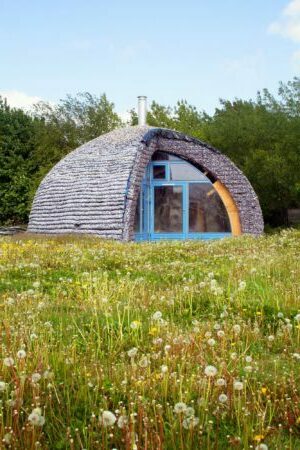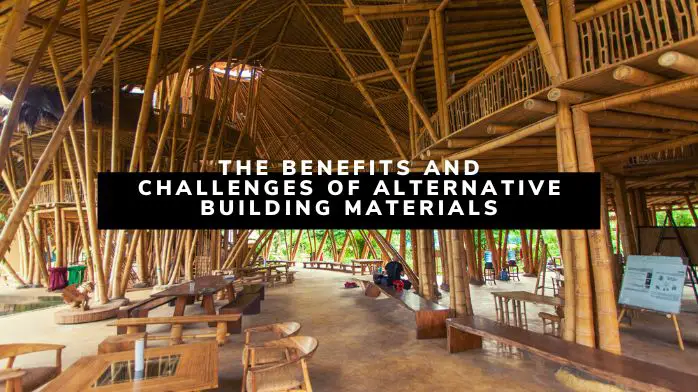Many alternative building materials can be used in place of traditional materials like concrete, wood, and brick. Some examples include:
- Bamboo: Bamboo is a strong and durable material used for flooring, framing, and decorative elements in buildings.
- Recycled plastic: Recycled plastic can be used to create a variety of building materials, including decking, siding, and insulation.
- Rammed earth: Rammed earth is made by compacting layers of wet soil or clay to create a strong and durable building material.
- Straw bale: Straw bale construction involves using bales of straw as a building material, often as insulation or as a load-bearing element in walls.
- Cob: A mixture of clay, sand, and straw can create buildings’ walls and other structural elements.
- Hempcrete: Hempcrete is a mix of hemp fibers, lime, and water that can create insulation, walls, and other building elements.
- Papercrete: Papercrete is a mixture of paper, cement, and water that can be used to create blocks or panels for walls and other structural elements.
- Mycelium: Mycelium is the vegetative part of a fungus, and it can be used to create various building materials, including insulation and structural elements.
- Recycled tires: Old tires can be recycled and used to create various building materials, including insulation, flooring, and walls.
Bamboo
Bamboo is a strong and durable material used in various building applications. It is a renewable resource that grows quickly, making it an environmentally-friendly alternative to wood and other traditional building materials. Bamboo can be used for building flooring, framing, and decorative elements. It is also used to create furniture and other household items.
One of the main advantages of using bamboo in construction is its strength and durability. Bamboo has a tensile strength similar to steel, making it ideal for structural applications. It is also resistant to pests and rot, which makes it a good choice for outdoor structures and flooring.
There are a few challenges to using bamboo in construction. Finding bamboo products that meet local building codes cannot be easy, and importing bamboo from the countries where it is grown can be expensive. Additionally, bamboo products can be difficult to work with because they are often shipped in large, unwieldy bundles. However, these challenges can be overcome with careful planning and specialized equipment.

Recycled Plastic
Recycled plastic is a versatile and environmentally-friendly building material used in various applications. It is made from recycled plastic waste that would otherwise be sent to landfills. It can create various building materials, including decking, siding, and insulation.
One of the main advantages of using recycled plastic in construction is its durability. Plastic is resistant to rot, pests, and moisture, making it a good choice for outdoor structures and building elements exposed to them. It is also easy to maintain and requires very little upkeep.
Recycled plastic can be molded into various shapes and sizes, making it a versatile building material. It is also relatively lightweight, which makes it easy to transport and install.
There are a few challenges to using recycled plastic in construction. It is generally more expensive than traditional materials like wood and may not be as strong as other materials. Additionally, not all types of plastic are suitable for building applications, so carefully select the right type of plastic for the job.
Straw Bail
Straw bale construction involves bales of straw as a building material, often as insulation or as a load-bearing element in walls. Straw bale construction is a sustainable and energy-efficient building method that has been used for centuries in many parts of the world.
One of the main advantages of using straw bales in construction is their insulation value. Straw bales have a high insulation value, which can help to reduce energy costs and improve the comfort of a building. They are also environmentally friendly, made from a renewable resource, and require very little energy.
Straw bale construction can be used to create a variety of building types, including houses, commercial buildings, and community centers. It is suitable for both new construction and the retrofitting of existing buildings.
There are a few challenges to using straw bales in construction. They can be difficult to find in some areas and may be more expensive than traditional building materials. Straw bales are also prone to pests and rot if not properly protected and maintained. However, these challenges can be overcome with careful planning and appropriate construction techniques.
Cob
Cob is a building technique that combines clay, sand, and straw to create walls and other structural elements. It has been used for centuries in many parts of the world. It’s experiencing a resurgence in popularity due to its environmental benefits and the availability of modern construction techniques and materials.
One of the main advantages of using cob in construction is its environmental sustainability. Cob is made from locally-sourced materials, requiring very little energy to produce. It is also a carbon-neutral building material, as the carbon dioxide emissions associated with its production are offset by the carbon dioxide absorbed by the walls during the curing process.
Cob is a strong and durable building material resistant to pests, fire, and earthquakes. It is also thermally efficient, as the thick walls provide insulation and help regulate indoor temperatures.
There are a few challenges to using cob in construction. It can be labor-intensive to produce, requiring specialized equipment and trained workers. It is also susceptible to cracking if not properly cured and maintained. However, these challenges can be overcome with careful planning and appropriate construction techniques.
Hempcrete
Hempcrete is a building material made from a mixture of hemp fibers, lime, and water. It is used to create insulation, walls, and other building elements, and it has been used in construction for hundreds of years.
One of the main advantages of using hempcrete in construction is its environmental sustainability. Hemp is a renewable resource that requires very little water and pesticides to grow, and hempcrete production generates very little waste. Hempcrete is also a carbon-neutral building material, as the carbon dioxide emissions associated with its production are offset by the carbon dioxide absorbed by the walls during the curing process.
Hempcrete is a strong and durable building material resistant to pests, fire, and moisture. It is also thermally efficient, as the thick walls provide insulation and help regulate indoor temperatures.
There are a few challenges to using hempcrete in construction. It cannot be easy to find hempcrete products that meet local building codes and may be more expensive than traditional building materials. Additionally, hempcrete is unsuitable for load-bearing applications, so it is generally used in combination with other building materials. However, these challenges can be overcome with careful planning and appropriate construction techniques.
Papercrete
Papercrete is a building material made from paper, cement, and water. It is used to create blocks or panels for walls and other structural elements, and it has been used in construction for several decades.
One of the main advantages of using papercrete in construction is its environmental sustainability. Papercrete is made from recycled paper, reducing the waste sent to landfills. It is also a carbon-neutral building material, as the carbon dioxide emissions associated with its production are offset by the carbon dioxide absorbed by the walls during the curing process.
Papercrete is a strong and durable building material resistant to pests, fire, and moisture. It is also thermally efficient, as the thick walls provide insulation and help regulate indoor temperatures.
There are a few challenges to using papercrete in construction. Finding papercrete products that meet local building codes cannot be easy and may be more expensive than traditional building materials. Additionally, papercrete is unsuitable for load-bearing applications, so it is generally used in combination with other building materials. However, these challenges can be overcome with careful planning and appropriate construction techniques.
Mycelium
Mycelium is the vegetative part of a fungus, and it can be used to create various building materials, including insulation and structural elements. Mycelium is a sustainable and environmentally-friendly building material used for several decades.
One of the main advantages of using mycelium in construction is its environmental sustainability. Mycelium is a renewable resource that requires very little energy to produce, and it can be grown using waste materials like agricultural byproducts. It is also a carbon-neutral building material, as the carbon dioxide emissions associated with its production are offset by the carbon dioxide absorbed by the walls during the curing process.
Mycelium is a strong and durable building material resistant to pests, fire, and moisture. It is also thermally efficient, as it provides insulation and helps to regulate indoor temperatures.
There are a few challenges to using mycelium in construction. Finding mycelium products that meet local building codes cannot be easyoi9k, and they may be more expensive than traditional building materials. Additionally, mycelium is unsuitable for load-bearing applications, so it is generally used in combination with other building materials. However, these challenges can be overcome with careful planning and appropriate construction techniques.
Recycled Tires
Recycled tires can be used to create a variety of building materials, including insulation, flooring, and walls. Using recycled tires in construction is a sustainable and environmentally-friendly building method that helps to reduce waste and conserve resources.
One of the main advantages of using recycled tires in construction is their durability. Tires are designed to withstand a lot of wear and tear and resist rot, pests, and moisture. This makes them a good choice for outdoor structures and building elements exposed to them.
Recycled tires can be molded into various shapes and sizes, making them versatile building materials. They are also relatively lightweight, which makes them easy to transport and install.
There are a few challenges to using recycled tires in construction. Finding tire-based products that meet local building codes cannot be easy, and they may be more expensive than traditional building materials. Additionally, tire-based products may off-gas harmful chemicals, so it is important to carefully select products that have been treated to reduce the risk of chemical exposure. However, these challenges can be overcome with careful planning and appropriate construction techniques.
Conclusion
Many alternative building materials can be used in place of traditional materials like concrete, wood, and brick. These materials include bamboo, recycled plastic, rammed earth, straw bale, cob, hempcrete, papercrete, mycelium, and recycled tires.
Each of these materials has its unique benefits and challenges and can be used in various building applications. Some of the main advantages of using alternative building materials include their environmental sustainability, durability, and insulation value.
However, it is important to carefully consider each material’s specific properties and requirements when selecting it for a building project.

